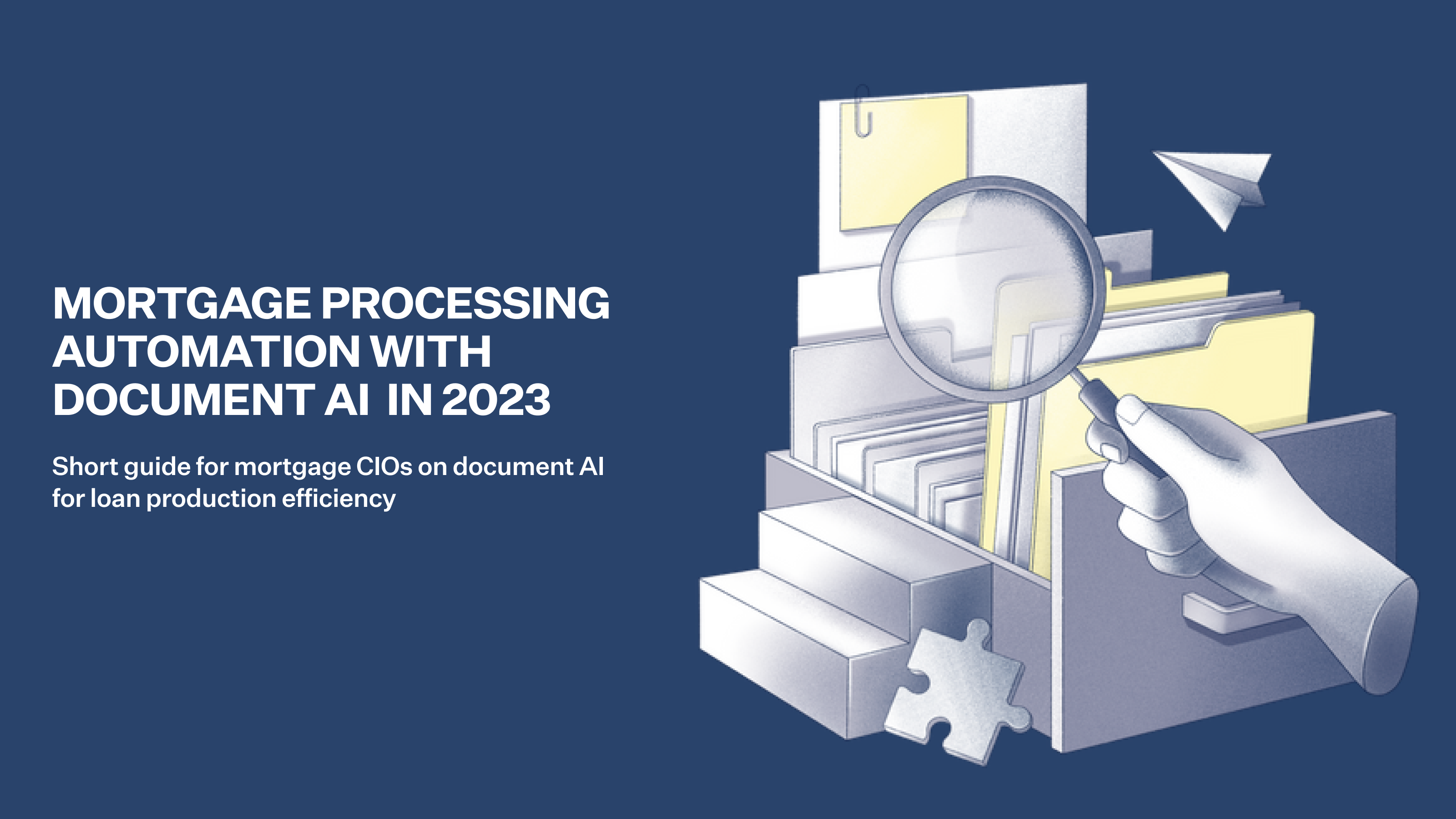Mortgage is a tough business to be in, especially when you’re hounded by - looming recession, Fed rate hike, inventory shortage & dipping loan productivity per FTE.
At the recently concluded MBA Annual Conference 2023, it became aptly clear that cost rationalization and back-office process efficiency are the two main drivers for mortgage lenders to automate their lending lifecycle.
There’s a 73% increase in mortgage lenders who cited operational efficiency as their prime motivation of adopting AI led automation in 2023.
While most CIOs & tech leaders are aware of the role digitization plays on the origination side to improve borrower experience - there’s a lot of ambiguity on automation plays that can move the needle on mortgage process efficiency.
With recent developments in Generative AI, we just saw more variables getting added to the entire equation.
For typical mortgage CXOs, the question arises - how to leverage AI & automation to improve FTE productivity while boosting profitability of their mortgage process through the rest of the year, going into 2024 ?
Need for AI led automation: Scoping the ‘Process’ problem
Closing a successful mortgage can get daunting for both the borrower and the lender.
On the borrower’s side, it starts with getting pre-approvals, finding a property and initiating a mortgage application with a loan officer.
On the lender’s side, teams have to process copious documents to issue loan estimates, complete a formal appraisal & detailed underwriting process - before approving the mortgage and sharing closing disclosures with the borrower.
The sheer number of documents and complexity of data that changes hands between borrowers & lenders - has an adverse impact on mortgage cycle time & cost to close.
As per a Freddie Mac study, an average lender that relies heavily on manual loan processing & underwriting takes 40-46 days to close a mortgage.
This is in sharp contrast to the top 25% lenders who have reduced mortgage cycle times by 30% - 50%.
What are these top performers doing differently ?
The top performers are typically lenders who leverage digital technology effectively and integrate digital enhancements along with making needed changes to process management and operations. - Freddie Mac (Mortgage Closing Cycle Time Benchmark Study)
In simple words, top lenders not only identified specific mortgage automation opportunities but also led change management to drive internal adoption.
The question is - How can mortgage CIOs learn from this to identify automation opportunities for improving mortgage process efficiency?
Based on our conversations with mortgage industry experts, we identified some key areas across the mortgage lifecycle where AI led automation can help unlock efficiency opportunities.
However, before delving into efficiency opportunities, let’s understand what we mean by AI led automation.
Document AI: Automating time-intensive document heavy processes
As seen above, mortgage is a document heavy process.
In order to drive efficiency, we need to make these processes error-free, fast and autonomous, such that the fulfillment team can focus on performing high value decisioning oriented tasks - rather than mundane data heavy chores.
This is where AI led Automation or Document AI comes into play.
Document AI is not just OCR or data capture or RPA.
It is about using complementary AI technologies on documents for faster, error-free and automated mortgage decisioning.
This means deploying an integrated system that uses a mix of AI-based OCR, machine learning models and even Generative AI agents to process loan data autonomously to the maximum extent possible - right from stare & compare, all the way to real-time underwrite decision support.
Such systems could:
- Identify documents, spot missing pages & stack them in the right order.
- Extract data from both standard forms and non-standard document types to directly key these into your loan origination and servicing systems.
- Auto-validate correctness of extracted data by cross referencing it with the source of truth.
- Act like an underwriting copilot that interprets borrower data in context to complex agency & non-agency guidelines and provide real-time decision support.
In a nutshell, it’s a careful orchestration of AI led automation capabilities for document intensive workflows.
To successfully deploy Document AI, we need to understand which areas of your mortgage lifecycle can benefit most from it.
Tailored application areas for Document AI across mortgage lifecycle
Given the broad scope of this conversation, we will split it into a two-part article series - loan production & loan servicing.
On the loan production side, there are four key areas where Document AI could act as value lever:
- Loan Application: Traditionally, the process of submitting a loan application has been manual & time consuming. It often involves borrowers going back & forth with their loan officers - sharing documents & proofs, till the loan processing team has all the information needed to issue a loan estimate. However, COVID became a forcing function for both borrowers & lenders. It led them to ditch the paper trail and adopt platforms like Blend & Reggora to digitize borrower applications & property appraisals. This helped lenders transform the customer facing stages of the mortgage journey into a frictionless digital experience.
- Loan Processing: On an average, a loan application can contain up to 200+ doc types - structured, unstructured & semi-structured data spread across PDFs, images, emails - online & offline - making it a complex set of documents to process.
When done manually, it's time consuming & error-prone: teams may spend up to 14 days in constant back & forth. This is just the tip of the iceberg.
Pre-processing alone could take 4 hours per loan package. This severely impairs scalability as well as borrower experience.
All of this inevitably hits customer experience - in fact the NPS scores for mortgage companies are 30% lower than other fintech SaaS companies.
Much worse, it can drive production expenses through the roof.
For example - as per MBA, production expense at the end of Q1 2023 was $13k per loan.
In a nutshell, manual loan processing is tedious, error-prone & time consuming - which makes it ripe for automation.
Document AI capabilities like automated document recognition & data extraction are ideally suited for the job.
Pre-trained NLP models combined with OCR are able to identify a wide range of documents, extract data, standardize the output as key value pairs and automatically punch in these data points directly into the lender's LOS. The biggest win in implementing Document AI is the ability to autonomously validate up to 75+% of unstructured & semi-structured data. However, if we’re able to integrate custom LLM models augmented on enterprise’s own data sources, then the straight through processing rate could go upto 88% - which means 50% less human validation tasks
On an average it could cut down the manual processing time & cost by nearly 80% per loan file.
- Loan Underwriting: Moving to loan underwriting - this is perhaps the most critical part of the mortgage lifecycle. On an average, every loan file takes 4 to 5 underwriter touches before closure. While lenders doing agency loans are able to use services like Fannie Mae’s Desktop Underwriter to fast-track their income verification process - the problem is much harder for non-conventional loans such as non-QMs, hardship loans etc. For example - bank statement loans to self-employed borrowers require non-QM lenders to pull income data from diverse sources such as invoices, tax returns & financial statements. Based on complex income computation, credit history & appraisal data - underwriters need to mine through pages of investor guidelines, to be able to qualify a borrower for a specific loan product.
This is not just tedious for the underwriting staff but also leads to a high denial rate (as high as 50%) amongst pre-approved self employed borrowers.
This is where automated underwriting, especially for non-QM lending, becomes a strong application area for Document AI.
Using Document AI APIs lenders can directly pull income data & credit history of self employed borrowers from banks, tax portals & credit bureaus. AI OCR can then be used to extract data from incoming JSON, XML & PDF files and spread it to automate income analysis. Going a step further - underwriting teams can use Generative AI chat applications, to extract decisioning insights from a myriad investor guidelines - simply by asking human-like questions & getting recommended actions along with detailed explanations.
The key here is to augment & train Generative AI models on your own data set such that it doesn't hallucinate and gives highly accurate & repeatable results, each time.
This can not only bring up the accuracy of your income analysis workflow but also bring down the time to underwrite to under hours & not days.
- Loan Closing & Post Close Audit: The final step of mortgage production is issuing the closing disclosure & performing post close QC. On the front of closing disclosures, lenders have been using eVaults and more recently RON for digital notarization. However, on the front of post close QC - there’s much scope for automation led efficiency gains. Often lenders process hundreds of loans a month, spanning 15+ document types. Doing a manual post close audit, can bloat the average handling time (AHT) to a couple of hours per loan file. Using Document AI for post close audit, can significantly bring down time & cost, through three key capabilities:Auto-classify & index 200+ document types & sub-types. Automate data extraction from structured to unstructured data using pre-trained AI models. Auto-validate data with inbuilt audit checklist & bookmark low confidence data for manual review.
In a nutshell, this can help post close teams not only achieve 85% straight through processing but also reduce cycle times by 80%.
Wrap up
On the loan production side, we saw that Document AI led automation can be deployed all the way from loan processing to post-close QC. While many of these automation capabilities do exist today - unfortunately most are available as separate point solutions and some such as Generative AI are still in early adoption stage.
This makes life tough for lenders, especially when they have to evaluate solution stack for their automation needs on a turnkey basis.
The most feasible workaround is to look for solution providers that solve connected use cases using a full suite AI stack consisting of NLP engines, AI OCR and custom LLM models. Using such solution partners - you can automate loan processing, income verification, underwriting and TRID compliance, in one go.
In the part-II of this article series, we’ll understand how Document AI can automate key areas of mortgage servicing.



